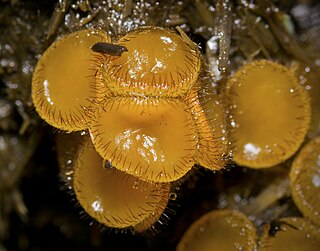
Meiosis is a special type of cell division of germ cells in sexually-reproducing organisms used to produce the gametes, such as sperm or egg cells. It involves two rounds of division that ultimately result in four cells with only one copy of each paternal and maternal chromosome (haploid). Additionally, prior to the division, genetic material from the paternal and maternal copies of each chromosome is crossed over, creating new combinations of code on each chromosome. Later on, during fertilisation, the haploid cells produced by meiosis from a male and female will fuse to create a cell with two copies of each chromosome again, the zygote.

Sordaria fimicola is a species of microscopic fungus. It is commonly found in the feces of herbivores. Sordaria fimicola is often used in introductory biology and mycology labs because it is easy to grow on nutrient agar in dish cultures. The genus Sordaria, closely related to Neurospora and Podospora, is a member of the large class Sordariomycetes, or flask-fungi. The natural habitat of the three species of Sordaria that have been the principal subjects in genetic studies is dung of herbivorous animals. The species S. fimicola is common and worldwide in distribution. The species of Sordaria are similar morphologically, producing black perithecia containing asci with eight dark ascospores in a linear arrangement. These species share a number of characteristics that are advantageous for genetic studies. They all have a short life cycle, usually 7–12 days, and are easily grown in culture. Most species are self-fertile and each strain is isogenic. All kinds of mutants are easily induced and readily obtainable with particular ascospore color mutants. These visual mutants aid in tetrad analysis, especially in analysis of intragenic recombination.

Panaeolus cinctulus, syn. Panaeolus subbalteatus, commonly known as the banded mottlegill, weed Panaeolus or subbs is a very common, widely distributed psilocybin mushroom. According to American naturalist and mycologist David Arora, Panaeolus cinctulus is the most common psilocybin mushroom in California.

Panaeolus is a genus of small, black-spored, saprotrophic agarics. The word Panaeolus is Greek for "all variegated", alluding to the spotted gills of the mushrooms produced.

Pholiotina rugosa is a common lawn mushroom which is widely distributed and especially common in the Pacific Northwest. It also grows on woodchips, rich soil and compost. It has been found in Europe, Asia and North America. It contains the same mycotoxins as the death cap. It is more commonly known as Conocybe filaris as this is the name it is likely to appear under in field guides. However, Conocybe filaris is a junior synonym of Pholiotina rugosa. Pholiotina rugosa has also been placed in the genus Conocybe, but its morphology and a 2013 molecular phylogenetics study place it in the genus Pholiotina. Pholiotina fimicola, which grows on dung and rich soil in North America is a possible synonym. Pholiotina arrhenii has also been considered a possible synonym, but a molecular phylogenetics study found it to be a distinct species.

Panaeolus olivaceus is a widely distributed, seldom identified, little brown mushroom that contains the hallucinogen psilocybin; it is often mistaken for Panaeolina foenisecii and is distinguished by its black spore print and darker gill coloration when mature alongside a slightly thicker stem. It is even more easily mistaken for Panaeolus cinctulus or Panaeolus fimicola and can be distinguished from them both by its slightly roughened spores. It is also easily confused with Panaeolina castaneifolia, a species which has spores that are dark brown and significantly more roughened.

Panaeolus fimicola is a widespread but seldom identified "little brown mushroom" which sometimes contains small amounts of the hallucinogen psilocybin. Panaeolis ater is a synonym. The species is also referred to as the "turf mottlegill".
Hyphomycetes are a form classification of Fungi, part of what has often been referred to as Fungi imperfecti, Deuteromycota, or anamorphic fungi. Hyphomycetes lack closed fruit bodies, and are often referred to as moulds. Most hyphomycetes are now assigned to the Ascomycota, on the basis of genetic connections made by life-cycle studies or by phylogenetic analysis of DNA sequences; many remain unassigned phylogenetically. Identification of hyphomycetes is primarily based on microscopic morphology including: conidial morphology, especially septation, shape, size, colour and cell wall texture, the arrangement of conidia as they are borne on the conidiogenous cells, the type of conidiogenous cell, and other additional features such as the presence of sporodochia or synnemata.

Xyletinus is a genus of death-watch and spider beetles in the family Ptinidae and subfamily Xyletininae.
Micromastia is a genus of fungi in the Ascomycota phylum. The two known members are Micromastia fimicola. and Micromastia trigonospora. The relationship of this taxon to other taxa within the phylum is unknown, and it has not yet been placed with certainty into any class, order, or family.
Schizothecium is a genus of fungi in the family Lasiosphaeriaceae.

Ascosphaera is a genus of fungi in the family Ascosphaeraceae. It was described in 1955 by mycologists Charles F. Spiltoir and Lindsay S. Olive. Members of the genus are insect pathogens. The type species, A. apis, causes chalkbrood disease in honey bees. The reproductive ascospores of the fungus are produced within a unique structure, the spore cyst, or sporocyst.
Sphaerodes is a genus of fungi within the Ceratostomataceae family.

Macrochelidae is a family of mites in the order Mesostigmata, containing the following genera and species:
Glyptholaspis is a genus of mites in the family Macrochelidae. There is one described species in Glyptholaspis, G. fimicola.

Cheilymenia fimicola is a species of apothecial fungus belonging to the family Pyronemataceae.
Cercophora areolata is a member of the Ascomycota division, and is grouped into the Lasiosphaeriaceae family based on morphology. C. areolata is a coprophilous fungus that has been most recently isolated from porcupine dung. Defining features of C. areolata include: 1) ovoid-conical, glabrous ascomata, 2) black, carbonaceous, areolate peridium and 3) clavate-shaped, single-walled asci. From studies on C. areolata, this fungus produces multiple antifungal compounds, which inhibit other competitor fungi.









